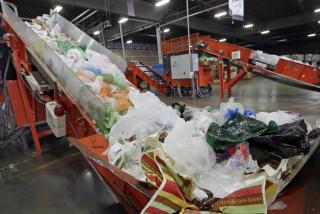Long Beach Hopes to Start Curb-Side Recycling in 1990
- Share via
LONG BEACH — The mindless weekly ritual of taking out the trash is about to require a bit more thought.
Recycling is coming. Residents will be asked to salvage bottles, aluminum cans and newspapers from the rest of their refuse.
Long Beach officials say they hope curb-side recycling will put a dent in the city’s huge volume of trash, thereby reducing dumping costs at near-capacity landfills. Recycling also would make the city’s trash-to-energy plant operate more efficiently by removing items that won’t burn.
“I think it (recycling) is of utmost importance,” Mayor Ernie Kell said. “Burning trash is fine, but we need to start recycling some of this.”
Mentioned in Budget
The City Council is considering the matter, but officials are still months away from concocting a workable recycling plan. They agree, however, with the goal of starting curb-side recycling next year.
City Manager James C. Hankla discussed the recycling plan in his budget recommendation for the coming fiscal year, but did not include start-up funds for it.
As good as recycling sounds, it is not exactly a profitable proposition. Every recycling program in the county costs more to operate than it earns in sales of recyclables, according to Bill George, who monitors recycling for the Los Angeles County Sanitation Districts. Some cities have increased trash collection rates to provide for recycling.
Nevertheless, recycling is increasingly popular among cities as a way of helping to cope with the so-called “garbage crisis,” the problem of what to do with trash once Southland landfills reach capacity in the next few years. Until two years ago, only Downey, Santa Monica, Burbank and Claremont had active curb-side collection programs. Since then, six other cities have started full-fledged curb-side recycling or pilot programs.
Together, they collect 1,130 tons of recyclable materials a month.
Recycling was supposed to have begun in Long Beach with the start-up of the city’s Southeast Resource Recovery Facility on Terminal Island, which burns trash to produce electricity. But city engineers say they have been so busy dealing with problems at the plant that the recycling program has fallen six months behind schedule.
“We played the hand we were dealt,” Assistant City Manager John Shirey said. “We had to worry about SERRF because that was the instant issue fraught with risk--high-dollar risk--and certain problems. If people think we’ve dilly-dallied around, we haven’t.”
Recycling is important to the trash-to-energy plant because it not only separates many non-flammable items, but prevents the burning of newsprint, which can produce chemical-laden smoke because of the metal content of various colored inks, said Martha Gildart, an engineer for the California Waste Management Board.
Plans are moving ahead at a quickening pace. William Davis, Long Beach’s solid waste manager, said the city has a $30,000 contract with consultants who are studying how cans and bottles could best be recycled in restaurants, how to salvage dead batteries from cars and whether city crews could compost grass clippings and tree trimmings. The city is looking for a recycling coordinator.
Plans call for a citizens advisory committee to help formulate the program and to sell the idea to the public. After all of the meetings, the actual design of Long Beach’s program would start in December.
Long Beach’s efforts come as landfill dumping rates are rising. The county Sanitation Districts plans a $1.50 raise in the price of dumping one ton of trash in its Puente Hills landfill, the primary dump site for Long Beach, Davis said. Long Beach residents generate about 300,000 tons of garbage a year.
But as the trash business goes, material actually recycled is a veritable drop in the landfill.
Recycling specialist George said only about a third of all waste is generated by residents. The rest is commercial or construction waste, such as asphalt from torn-up streets or chunks of concrete from demolished buildings, he said.
Much of the residential trash already is being combed for bottles, cans and newspapers on a voluntary basis. The state Division of Recycling, which pays the state’s one-cent-a-container bounty for used bottles and cans, estimates that 60% of the aluminum cans and 40% of the bottles are already being returned.
Most curb-side recycling programs are voluntary, with participation by residents generally under 50%. All told, George said, residential recycling could realistically be expected to cut the total amount of trash by about 7%.
“It’s a start,” he said.
City Won an Exemption
While proceeding with a recycling program, Long Beach has left itself a legal out. Arguing that its trash-to-energy plant shows the city’s commitment to reducing its volume of waste, the city successfully lobbied for an exemption to a bill last year that would require cities to start curb-side recycling programs. While Gov. George Deukmejian vetoed the measure, a bill with the exemption intact was resurrected in the Legislature this year.
Some recycling activists believe the city should move faster.
“They are going too slow. They should have started three years ago,” said Long Beach recycling advocate Virginia Siegel. “When they accepted the incinerator, it was with recycling included.”
Kell said he is in no hurry for the start of a recycling program. “Recycling is something we have to take slowly,” the mayor said at a recent City Council meeting. “It’s going to take an education program, (and) if implemented it’s going to create extra work for the residents, but it’s something . . . that’s important. I would hope that residents would buy into it.”
More to Read
Sign up for Essential California
The most important California stories and recommendations in your inbox every morning.
You may occasionally receive promotional content from the Los Angeles Times.













